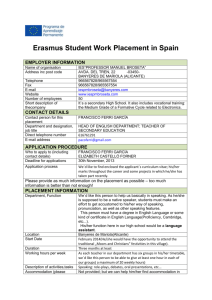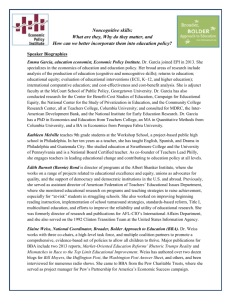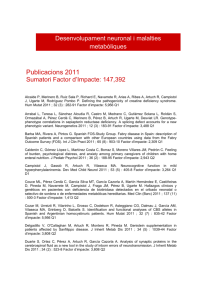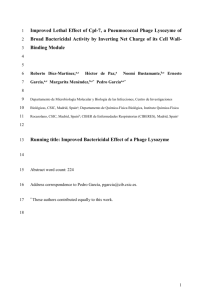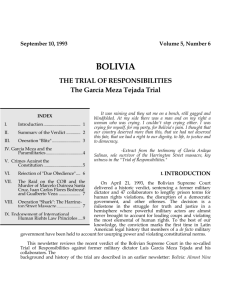emi412295-sup-0003-si
advertisement
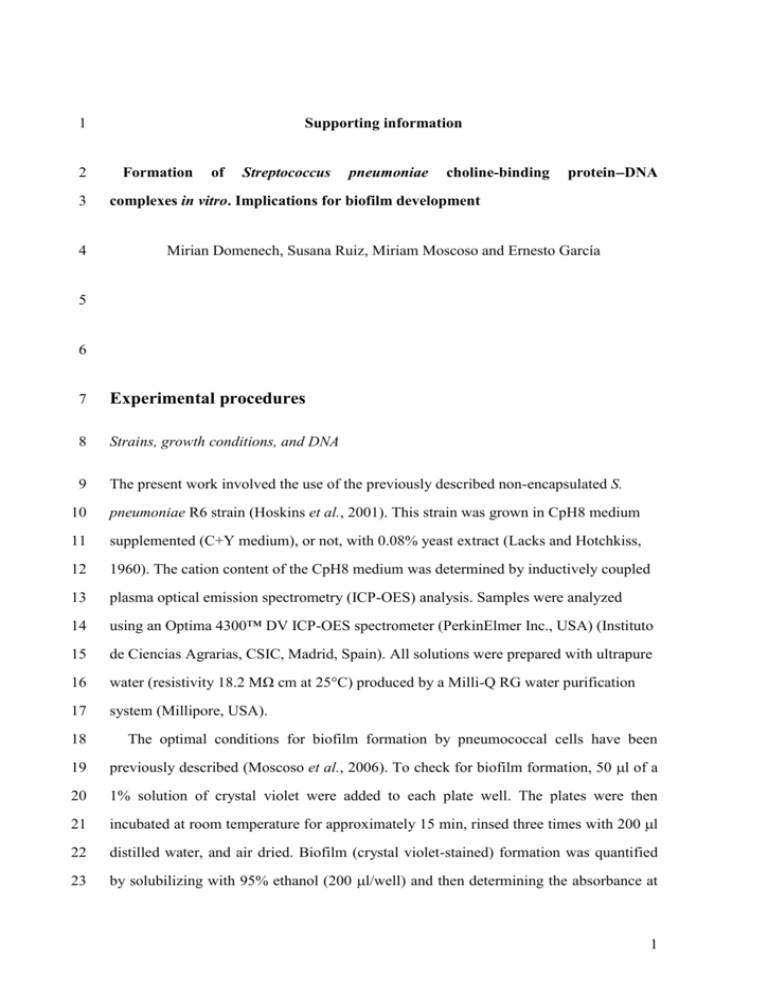
1 2 3 4 Supporting information Formation of Streptococcus pneumoniae choline-binding proteinDNA complexes in vitro. Implications for biofilm development Mirian Domenech, Susana Ruiz, Miriam Moscoso and Ernesto García 5 6 7 Experimental procedures 8 Strains, growth conditions, and DNA 9 The present work involved the use of the previously described non-encapsulated S. 10 pneumoniae R6 strain (Hoskins et al., 2001). This strain was grown in CpH8 medium 11 supplemented (C+Y medium), or not, with 0.08% yeast extract (Lacks and Hotchkiss, 12 1960). The cation content of the CpH8 medium was determined by inductively coupled 13 plasma optical emission spectrometry (ICP-OES) analysis. Samples were analyzed 14 using an Optima 4300™ DV ICP-OES spectrometer (PerkinElmer Inc., USA) (Instituto 15 de Ciencias Agrarias, CSIC, Madrid, Spain). All solutions were prepared with ultrapure 16 water (resistivity 18.2 MΩ cm at 25°C) produced by a Milli-Q RG water purification 17 system (Millipore, USA). 18 The optimal conditions for biofilm formation by pneumococcal cells have been 19 previously described (Moscoso et al., 2006). To check for biofilm formation, 50 l of a 20 1% solution of crystal violet were added to each plate well. The plates were then 21 incubated at room temperature for approximately 15 min, rinsed three times with 200 l 22 distilled water, and air dried. Biofilm (crystal violet-stained) formation was quantified 23 by solubilizing with 95% ethanol (200 l/well) and then determining the absorbance at 1 24 595 nm (A595). The results show the mean ± standard error of at least four independent 25 experiments, each performed in triplicate. For biofilm inhibition assays, all required 26 reagents were incubated with the cells from the very beginning of growth, unless stated 27 otherwise. The appropriate buffer for each case was then added. Plates were incubated 28 at 34C under the conditions described in each experiment. 29 Plasmid pGL30 (12 kb), constructed in our laboratory, is a pBR322 derivative 30 containing a 7.5 kb BclI-fragment of pneumococcal DNA (García et al., 1985), and has 31 been used in previous work on proteinDNA binding experiments (Domenech et al., 32 2013). The chromosomal DNA from Mycobacterium smegmatis mc2155 used in the 33 different experiments was a generous gift of B. Galán (Centro de Investigaciones 34 Biológicas, CSIC, Madrid). S. pneumoniae DNA was purified as previously described 35 (Domenech et al., 2013). Agarose gel (0.7%) electrophoresis was performed as 36 described elsewhere (López et al., 1984). 37 Purification of CBPs 38 CBPs overproduced by E. coli strains, were purified by affinity chromatography on 39 DEAE cellulose (Sánchez-Puelles et al., 1992). LytA (García et al., 1987), LytB and 40 GFP-LytB (De las Rivas et al., 2002), LytC and LytCE365Q (García et al., 1999; Pérez- 41 Dorado et al., 2010), Pce (de las Rivas et al., 2001; Hermoso et al., 2005), and CbpF 42 (Molina et al., 2009) were overproduced and purified as previously reported. The 43 purification of the cell wall-binding domain of LytA (C-LytA) has been described 44 elsewhere (Sánchez-Puelles et al., 1990). A purified preparation of an enzymatically 45 inactive LytA (LytAH133A) was kindly provided by Pedro García and Blas Blázquez. The 46 enzymatically inactive form of LytB (LytBE564A) containing a Glu564→Ala mutation 47 was kindly supplied by Palma Rico and Margarita Menéndez (Departamento de 48 Química-Física Biológica, Instituto Química-Física “Rocasolano”, CSIC, Madrid, 49 Spain). The 564 position corresponds to that in the unprocessed protein. Pure PspC was 50 generously provided by Abiodun D. Ogunniyi (Research Centre for Infectious Diseases, 2 51 School of Molecular and Biomedical Science,University of Adelaide, Adelaide, 52 Australia). 53 Visualization of proteinDNA complexes 54 ProteinDNA complexes were examined using epifluorescence and confocal laser 55 scanning microscopy (CLSM). Complexes of GFPLytB and pGL30 were incubated for 56 15 min at 4°C in the dark with the trimethine cyanine homodimer dye BOBO™-3 57 iodide (570/602) (Invitrogen, Karlsruhe, Germany) — a DNA intercalating fluorophore 58 providing enhanced fluorescence upon binding to double-stranded DNA. Observations 59 were made either at a magnification of 100× using a Leica DFC360-FX epifluorescence 60 microscope, or at 63× using a Leica TCS-SP2-AOBS-UV CLSM equipped with an 61 argon ion laser. Images were analyzed using LEICA AF 6000-DFC and LCS software 62 respectively. 63 Unfixed proteinDNA complexes were placed on Formvar-carbon coated copper 64 grids, air dried, and examined using a JEOL JEM 1010 transmission electron 65 microscope (Centro Nacional de Microscopía Electrónica, Universidad Complutense, 66 Madrid, Spain). For the observation of proteinDNA complexes (supported on mica), 67 samples were kindly prepared by María Teresa Rejas (Centro de Biología Molecular, 68 CSIC, Madrid, Spain), following an established procedure (Sogo et al., 1976). 69 Localization of LytBeDNA complexes in S. pneumoniae biofilms 70 To localize LytB-eDNA complexes in S. pneumoniae biofilms using CLSM, the R6 71 strain was grown in glass-bottomed dishes (WillCo-dish®, WillCo Wells B.V., 72 Amsterdam, The Netherlands) for up to 5 h at 34°C, as previously described (Moscoso 73 et al., 2006). The biofilm was incubated for 1 h at 4°C with anti-LytB serum (raised in 74 mice and kindly provided by J. Yuste and B. Corsini) (diluted 1/10 in PBS) followed by 75 an incubation of 30 min at 4°C in the dark with Alexa fluor 568-labeled goat anti-mouse 76 IgG (diluted 1/500) and 10 M SYTO 9 (Life Technology) in 10 mM Tris-HCl buffer, 3 77 pH8.8. The biofilms were then stained with DDAO [7-hydroxy-9H-(1,3-dichloro-9,9- 78 dimethylacridin-2-one)] for 10–20 min at room temperature in the dark. Observations 79 were made at a magnification of 63× and zoom 2 as detailed above. Projections were 80 obtained in the planes x–y (individual scans at 1 mm intervals) and xz (images at 5 m 81 intervals). 82 Protein techniques 83 The purity of CBPs was determined by SDS-polyacrylamide gel electrophoresis 84 (Laemmli, 1970) in 10% polyacrylamide gels, and protein bands were visualized by 85 staining with Coomassie brilliant blue R250. To test for the absence of nucleases, the 86 diverse CBP preparations (5 g) were incubated with pGL30 (100 ng) in PBS 87 containing 10 mM MgCl2 for 1 h at 37°C. Then, proteinase K (100 g/ml) was added 88 and incubation proceeded for one additional hour. Portions of the mixtures were 89 analyzed by 0.7% agarose gel electrophoresis (see above). 90 The predicted isoelectric points for proteins and peptides were calculated using either 91 of two programs available at (http://mobyle.pasteur.fr/cgi-bin/portal.py?#forms::iep or 92 http://isoelectric.ovh.org/). The pLytB-derived peptides were synthesized using a Focus 93 XC automated peptide synthesizer (AAPPTec, Lousville, KY, USA) applying standard 94 solid phase Fmos protocols. The following 25/26-amino acid-long synthetic peptides, 95 derived from the 635-amino acid-long mature LytB were used in DNApeptide binding 96 experiments: P_LytB1 (578-KGILGATKWIKENYIDRGRTFLGNK-602; predicted pI 97 10.8 ); P_LytB2 (569-ENYIDRGRTFLGNKASGMNVEYASD-613; predicted pI 4.5); 98 P_LytB4 (528-HINALYLLAHSALESNWGRSKIAKDK-553; predicted pI 10.1). 99 Numbers correspond to amino acid positions in mature LytB. Amino acid residues 100 overlapping in peptides P_LytB1 and P_LytB2 are shown underlined. Peptide P_LytB3 101 (DIGGNKTLLKKWRIFITRNYAGGKE; predicted pI 10.8) has the same amino acid 102 composition as P_LytB1, but its primary structure was randomly generated 103 (http://web.expasy.org/randseq/). Peptide P_LytB5 4 104 (HINALYLLAHSALASNWGRSKIAKDK; predicted pI 10.6) is identical to P_LytB4 105 except that the essential catalytic residue Glu-541 (Bai et al., 2014), which is 106 highlighted in a black background and corresponds to Glu-564 in the unprocessed 107 protein, was substituted by Ala. 108 Statistical analysis 109 The data for biofilm formation include the mean ± standard error of at least three 110 independent experiments, each performed in triplicate. Statistical significance was 111 examined using the Student t test. Differences were considered statistically significant 112 when P <0.05. 113 References 114 Bai, X.-H., Chen, H.-J., Jiang, Y.-L., Wen, Z., Huang, Y., Cheng, W. et al. (2014) 115 Structure of pneumococcal peptidoglycan hydrolase LytB reveals insights into the 116 bacterial cell wall remodeling and pathogenesis. J Biol Chem 289: 2340323416. 117 de las Rivas, B., García, J.L., López, R., and García, P. (2001) Molecular 118 characterization of the pneumococcal teichoic acid phosphorylcholine esterase. 119 Microb Drug Resist 7: 213222. 120 De las Rivas, B., García, J.L., López, R., and García, P. (2002) Purification and polar 121 localization of pneumococcal LytB, a putative endo--N-acetylglucosaminidase: the 122 chain-dispersing murein hydrolase. J Bacteriol 184: 49885000. 123 Domenech, M., García, E., Prieto, A., and Moscoso, M. (2013) Insight into the 124 composition of the intercellular matrix of Streptococcus pneumoniae biofilms. 125 Environ Microbiol 15: 502516. 126 García, E., García, J.L., Ronda, C., García, P., and López, R. (1985) Cloning and 127 expression of the pneumococcal autolysin gene in Escherichia coli. Mol Gen Genet 128 201: 225230. 5 129 García, J.L., García, E., and López, R. (1987) Overproduction and rapid purification of 130 the amidase of Streptococcus pneumoniae. Arch Microbiol 149: 5256. 131 García, P., González, M.P., García, E., García, J.L., and López, R. (1999) The 132 molecular characterization of the first autolytic lysozyme of Streptococcus 133 pneumoniae reveals evolutionary mobile domains. Mol Microbiol 33: 128138. 134 Hermoso, J.A., Lagartera, L., González, A., Stelter, M., García, P., Martínez-Ripoll, M. 135 et al. (2005) Insights into pneumococcal pathogenesis from the crystal structure of 136 the modular teichoic acid phosphorylcholine esterase Pce. Nat Struct Mol Biol 12: 137 533538. 138 Hoskins, J., Alborn, W.E., Jr., Arnold, J., Blaszczak, L.C., Burgett, S., DeHoff, B.S. et 139 al. (2001) Genome of the bacterium Streptococcus pneumoniae strain R6. J 140 Bacteriol 183: 57095717. 141 142 143 144 145 Lacks, S., and Hotchkiss, R.D. (1960) A study of the genetic material determining an enzyme activity in Pneumococcus. Biochim Biophys Acta 39: 508518. Laemmli, U.K. (1970) Cleavage of structural proteins during the assembly of the head of bacteriophage T4. Nature 227: 680685. López, R., Ronda, C., García, P., Escarmís, C., and García, E. (1984) Restriction 146 cleavage maps of the DNAs of Streptococcus pneumoniae bacteriophages containing 147 protein covalently bound to their 5' ends. Mol Gen Genet 197: 6774. 148 Molina, R., González, A., Stelter, M., Pérez-Dorado, I., Kahn, R., Morales, M. et al. 149 (2009) Crystal structure of CbpF, a bifunctional choline-binding protein and 150 autolysis regulator from Streptococcus pneumoniae. EMBO Rep 10: 246251. 151 Moscoso, M., García, E., and López, R. (2006) Biofilm formation by Streptococcus 152 pneumoniae: role of choline, extracellular DNA, and capsular polysaccharide in 153 microbial accretion. J Bacteriol 188: 77857795. 154 Paganelli, F.L., Willems, R.J.L., Jansen, P., Hendrickx, A., Zhang, X., Bonten, M.J.M., 155 and Leavis, H.L. (2013) Enterococcus faecium biofilm formation: identification of 156 major autolysin AtlAEfm, associated Acm surface localization, and AtlAEfm- 157 independent extracellular DNA release. mBio 4: e00154. 6 158 Pérez-Dorado, I., González, A., Morales, M., Sanles, R., Striker, W., Vollmer, W. et al. 159 (2010) Insights into pneumococcal fratricide from the crystal structures of the 160 modular killing factor LytC. Nat Struct Mol Biol 17: 576581. 161 Sánchez-Puelles, J.M., Sanz, J.M., García, J.L., and García, E. (1990) Cloning and 162 expression of gene fragments encoding the choline-binding domain of 163 pneumococcal murein hydrolases. Gene 89: 6975. 164 Sánchez-Puelles, J.M., Sanz, J.M., García, J.L., and García, E. (1992) Immobilization 165 and single-step purification of fusion proteins using DEAE-cellulose. Eur J Biochem 166 203: 153159. 167 Sogo, J.M., Greenstein, M., and Skalka, A. (1976) The circle mode of replication of 168 bacteriophage lambda: the role of covalently closed templates and the formation of 169 mixed catenated dimers. J Mol Biol 103: 537562. 7

